BUNYAVIRIDAE
General Characteristics
- Segmented, enveloped, ss, (-)RNA
- A large and widely diverse group of viruses.
- Virions have a complex construction.
- The virions vary in shape from spherical to pleomorphic.
- The nucleocapsids are elongated and have helical symmetry.
- These viruses contain no matrix proteins.
- Lipid-containing envelope, with 5 peplomers 5-10 nm in length, within which are three circular, helically symmetrical capsids.
- The envelope surrounds three nucleocapsids; has surface projections.
- Surface projections are distinctive spikes covering evenly the surface which are embedded in a lipid bilayer that is 5 nm thick.
- Virions contain lipids (phospholipids, sterols, fatty acids, and glycolipids) that are derived from the host cell (Golgi) membranes.
- The viruses are sensitive to heat, detergents, formaldehyde; some exhibit hemagglutinating activity.
- Some viruses have narrow host ranges and occur worldwide.
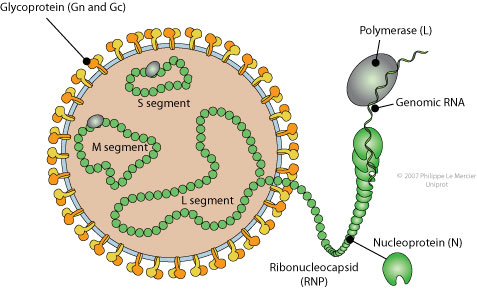
Source: Expasy-viral zone website.
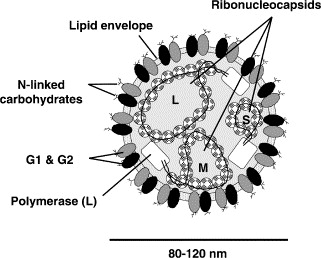
Source: vbi.vt.edu
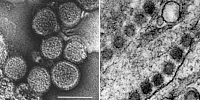
Source: ICTV
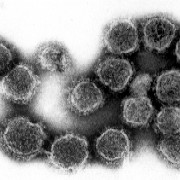
La cross virus
Source: UC-Davis, California
Taxonomy
Based on molecular and serological properties.
Family: Bunyaviridae (about 350 members in five genera)
Genus: Bunyavirus (>150 members)La Crosse virus
Bunyawera virus
Bwamba virus
Oriboca virus
Oropouche virus
Guama virus
Jamestown Canyon virus
California encephalitis virus
Snowshoe hare virus
Tahyna virus
Genus: Phebovirus (30 or so members)Sandfly fever-Naples virus
Sandfly fever-Sicilian virus
Rift Valley fever virus
Genus: Nairovirus (30 or so members)Nairobi sheep disease virus
Crimean-Congo hemorrhagic virus (Biosafety Level 4)
Genus: Hantavirus
Hantaan virus
Seul virus (hemorrhagic fever - renal)
Sin nombre virus (acute respiratory distress)
Puumala virus (nephropatia epidemica)
Genus: TospovirusTomato spotted wilt virus
They are transmitted to plants my minute insects called thrips.
Tospoviruses (named for the first virus in the genus to be identified, the Tomato spotted wilt virus). These viruses cause significant crop losses worldwide.
Genome
- The genome is monomeric and consists of three segments of linear negative-sense (or ambisense, depending on the genus) RNA.
- Ambisense means that some of the genes on the RNA strand are negative sense.
- (-)RNA's are non-messengers.
- Total genome size ranges from 11-19 kbp.
- Bunyaviruses have tripartite genomes consisting of a large (L), medium (M), and small (S) RNA segment.
- Each segment is enclosed (encapsidated) within a helical capsid.
- These RNA segments are single-stranded, and exist in a helical formation within the virion.
- The nucleotide sequences at the 3'-terminus and the 5'-terminus are complimentary, forming pseudo-circular structures (non-covalently closed circles).
- In the virion the linear genomes appear circular because the ends are held together by their unusual base-pairing.
- In common with all (-) RNAs, the 5' ends are not capped and the 3' ends are not polyadenylated.
- Terminal sequences of gene segments are conserved among viruses in each genus but are different among genera.
- The L segment encodes the RNA-dependent RNA polymerase, necessary for viral RNA replication and mRNA synthesis.
- The M segment encodes the viral glycoproteins, which project from the viral surface and aid the virus in attaching to and entering the host cell.
- The L and M segment are negative sense.
- The S segment encodes the nucleocapsid protein (N).
- For the genera of Phlebovirus and Tospovirus, the S segment is ambisense and codes for a non-structural protein (NSs).
More on the Ambisense Coding Strategy
- Phleboviruses and tospoviruses genera do appear to have one novel strategy, for synthesizing some of the proteins.
- The smallest of the three genomic RNA molecule (S segment) appear to be ambisense, that is, to be both positive- and negative-strand RNA at the same time.
- The genomic small RNA molecule thus encodes proteins in opposite directions at its two ends.
- Within the cell, transcripts and proteins are found that suggest both + and - sense processes.
- The viral genome may have either a + sense RNA that directly acts as mRNA, or the + sense transcripts from the - sense genome make further - sense transcripts that code for other mRNAs and + sense viral genome species.
- The mechanism for this somewhat complicated replicative cycle, as it is now recognized, is not known.
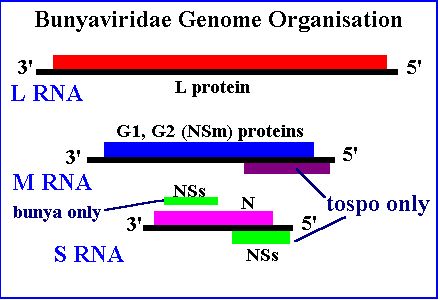
Source: University of Cape Town

Source: Viral Zone, Inc.
Replication
- Little is known about their transcription and replication.
- Bunyaviruses employ strategies similar to those used by other negative-stranded RNA viruses.
- The virion attaches to the surface of a host cell through the G1/G2 glycoproteins.
- The virus membrane fuses with the vesicle membrane through acidification of the endosome.
- Nucleocapsids are released into the cytoplasm allowing viral RNA-dependent RNA polymerase access to the cytoplasm.
- RNA-dependent RNA polymerase known as the nucleocapsid-associated L protein interacts with the three S, M, and L nucleocapsids.
- Primary transcription and translation of viral proteins take place.
- A switch from translation to replication occurs, and full-length cRNA templates are produced, from which full-length vRNA genomes are produced and encapsidated.
- The L segment encodes the viral transcriptase-replicase, the M segment the envelope glycoproteins, and the S segment the nucleocapsid protein.
- The RNA segments can cyclize because they have complementary, genus-specific, conserved terminal sequences at their 3' and 5' ends.
- Assembly occurs in cytoplasm via budding usually upon Golgi membranes -- An unsual event in viruses.
- Closely related viruses can reassort gene segments during mixed infections.
- The virions are transported to the cell surface in vesicles and are released by exocytosis or budding through the plasma membrane.
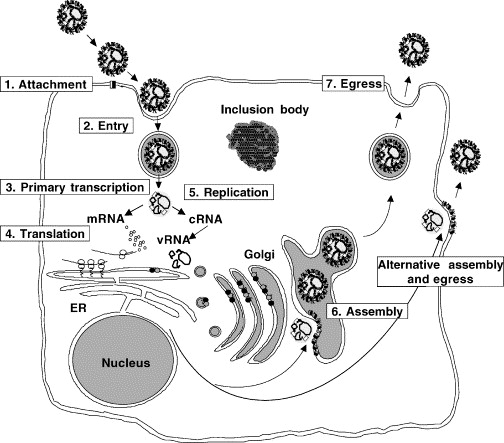
Source: pathport.vbi.vt.edu
Transmission
- Arthropod-transmitted except for the Hantavirus genus (not an Arbovirus).
- Bunyaviruses (except Hantaviruses) replicate in vertebrates and arthropods.
- Virions are usually highly specific for a certain arthropod species, and the vectors therefore constitute a large number of different species of ticks, mosquitoes and sandflies.
- Varios viruses are transmitted by mosquitos, ticks, flies, thrips, and other arthropods.
- Transovarian and venereal transmission occur in some vector mosquito species.
- The viruses are generally cytolyc in their vertebrate hosts, but not in their invertebrate hosts.
- Hantaviruses are transmitted by persistently infected rodents via aerosolization of urine, saliva, and feces.
- Incidence of infection is closely linked to vector activity, for example, mosquito-borne viruses are more common in the summer.
- Direct contact with virus-contaminated blood or tissues from infected animals or humans is another source of virus transmission and is generally characterized by more severe clinical symptoms and high mortality.

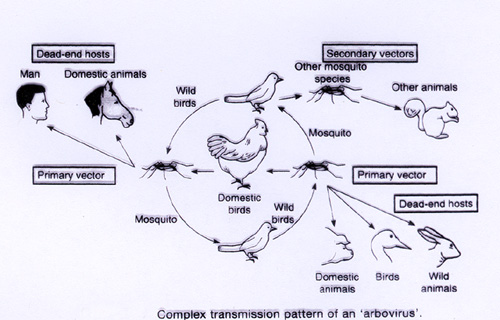
Diseases in Humans
- A Hantaan virus was found as the cause of an acute respiratory disease often leading to death in Navajo Indians living in New Mexico.
- The cause of this illness was determined by epidemiological studies that suggested the transmission by rodent droppings.
- Subsequent growth of the virus in cell culture led to its identification
using PCR.